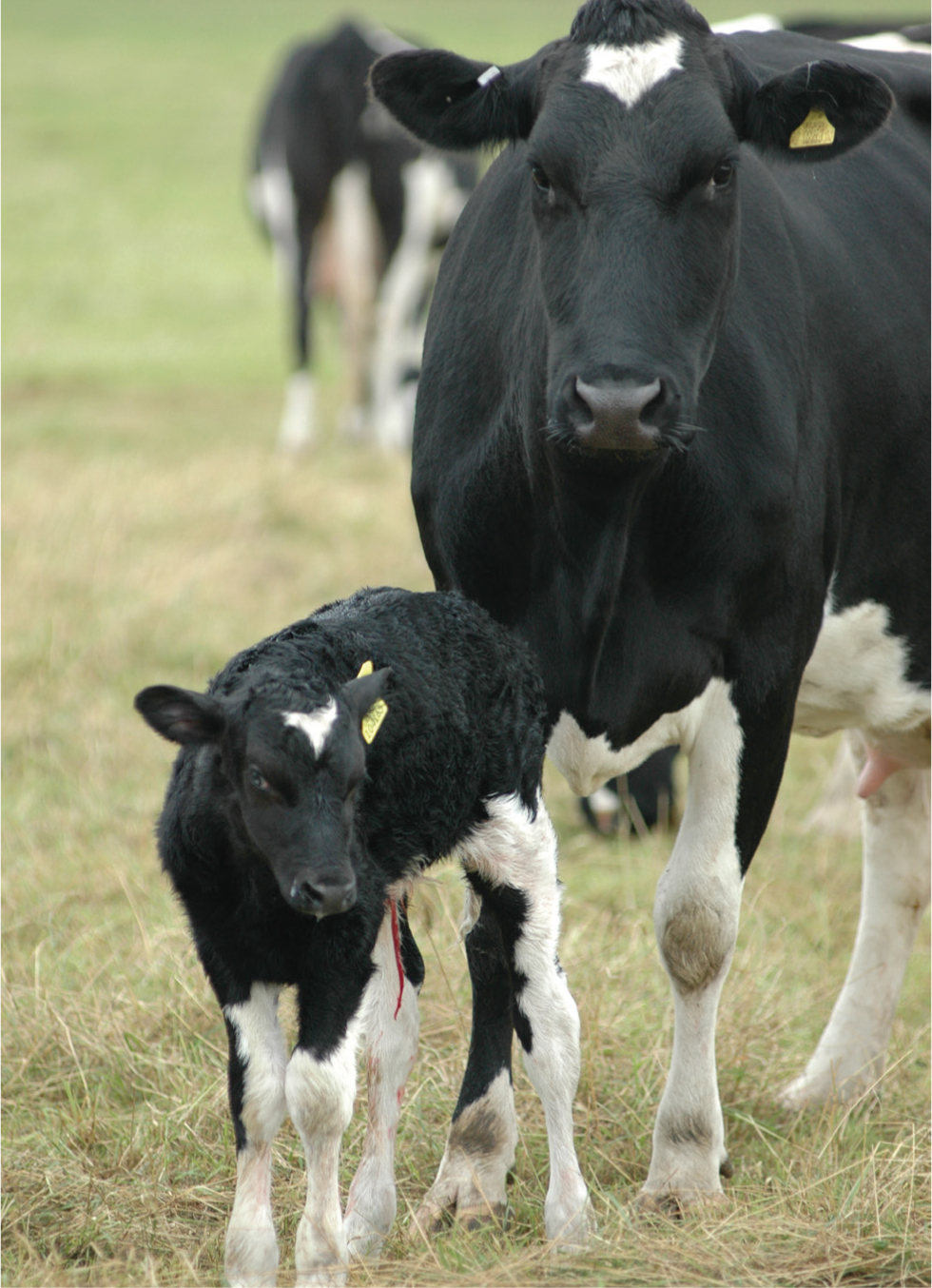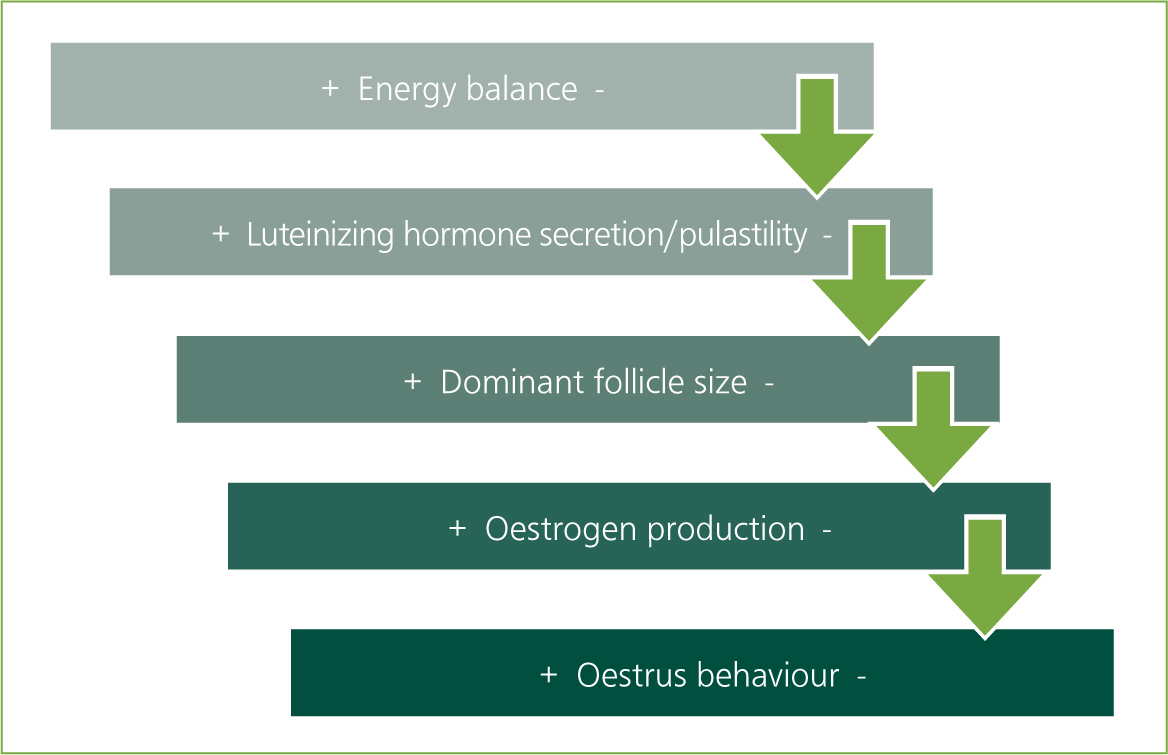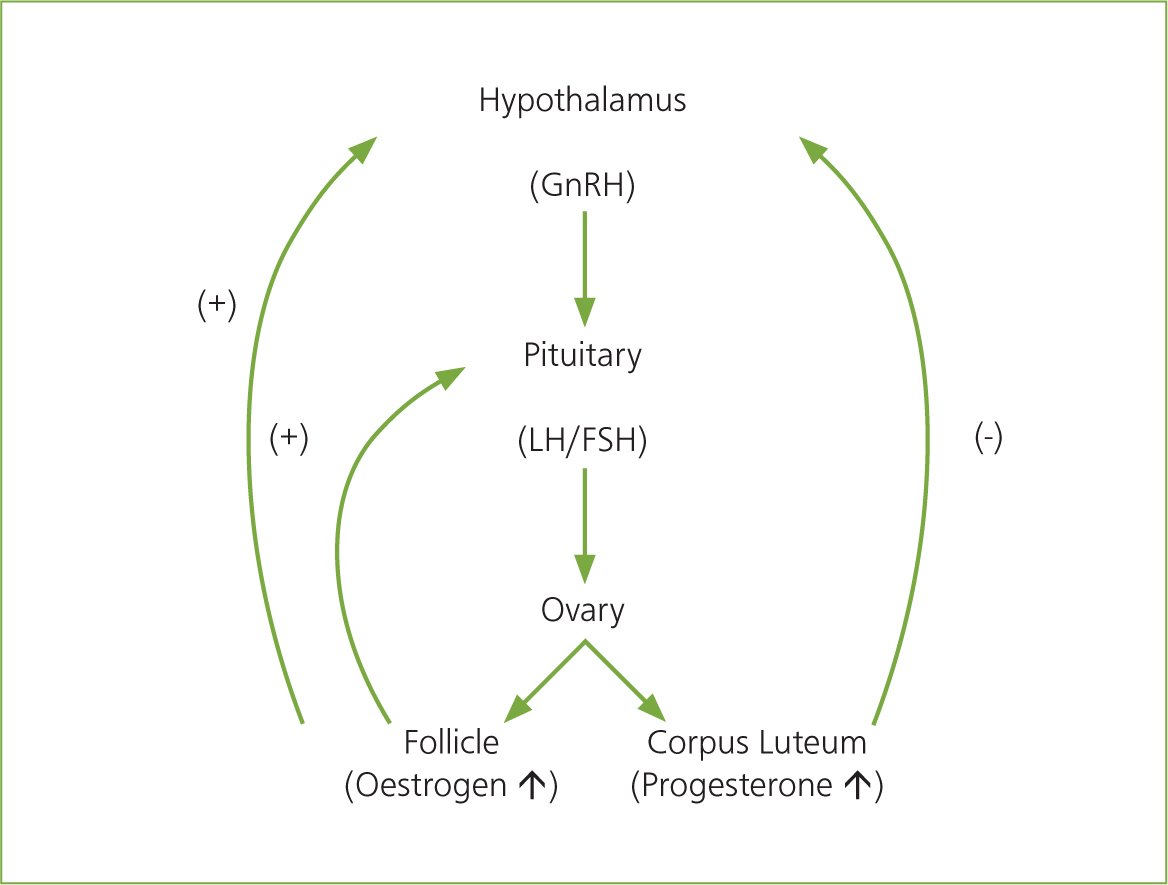Over the last 50 years, there has been a clear decline in fertility in the dairy herd (Royal et al, 2000; Butler, 2003; López-Gatius, 2003). Conception rates to first service have reduced from 55% to less than 40% (Royal et al, 2000). During this time, the dairy industry has also achieved a remarkable increase in the volume of milk produced per cow, likely achieved through a substantial increase in the proportion of Holstein-Friesian genetics in the herd (Royal et al, 2000). The push for more milk per cow has been widely discussed as an important contributor to the decline in reproductive performance (Figure 1). Within the cow, the effects on reproduction that result from lactation are complex.

There are an array of hormonal cascades that must occur in order to achieve successful reproduction (Lucy, 2001). The hypothalamo-pituitary-ovarian axis and the growth hormone-insulin-like growth factor axis are examples of two of these. A key driver of the success of the hormonal cascades, which has been identified in many studies, is energy balance within the cow. From the pre-calving period through until after mating has been completed, energy balance has a significant influence on reproductive success (Walsh et al, 2011).
Energy balance, liver function and fertility are closely interlinked, and this article aims to introduce how these processes have been affecting reproduction in the high yielding, modern dairy cow. There are a number of comprehensive reviews on this subject available, and the reader is directed to Lucy (2001), Butler (2003) and Walsh et al (2011) for more information on the subject. To review the reproductive cycle of the cow, please refer to Whitfield (2014).
Energy balance
Energy balance describes the ability of the cow to meet the energy demands required to maintain her physiological status. Energy balance is reliant on the amount of energy she can draw from what she is able to consume per day, as well as reasonable mobilisation of her body reserves. If a cow is underfed, fed a poor-quality diet, or is expending more in energy than she can take in per day, she will be in negative energy balance. As capacity for milk production has increased, the ability of the cow to meet her daily energy requirements without relying on mobilisation of her body reserves has become harder. Holstein-Fresian type cows are particularly good at mobilising body condition reserves in early lactation in order to support the energy demands of early lactation. Nutritional management is a critical component of managing energy balance in modern dairy cows.
Negative energy balance occurs due to mismatch between energy availability and energy outputs. Late gestation and early lactation are key times when almost all cows will experience negative energy balance to some degree. There is significant partitioning of nutrients towards fetal growth in late gestation, mammary development and lactation. The depth and duration of negative energy balance that a cow experiences determines the impact on her physiological and metabolic status, and particularly her subsequent fertility and reproductive success (Butler, 2003). High producing cows tend to mobilise more body condition around calving, and therefore may be more prone to experience negative energy balance if nutrition is not carefully considered.
Negative energy balance extends the calving to first ovulation interval, extends the calving to conception interval, as well as reduces the fertility of the immature oocytes which later become the oocytes selected for the cycles in which pregnancy may be established (Lucy et al, 1992; Butler, 2003; Pryce et al, 2004; Leroy et al, 2008).
Negative energy balance reduces the secretion of luteinizing hormone (LH); LH is the driver of follicular growth from deviation, when the new dominant follicle acquires LH receptors, until either atresia or ovulation of the dominant follicle occurs (Whitfield, 2014). A reduction in the pulsatility of LH reduces the size and quality of the dominant follicle in the first cycles after calving. Reduced dominant follicle size will also mean there is less oestrogen produced, as there are fewer granulosa cells. Oestrogen determines how strongly oestrus behaviour is displayed, and whether ovulation is achieved, therefore a reduction in oestrogen levels will negatively affect the display of oestrus behaviours (Figure 2). Oestrus behaviour must be sufficiently displayed in order to be detected by whichever management practice is employed as a heat detection method.

Problems arise with the time pressure the modern management system places on a cow. In order to produce efficiently a cow must be pregnant not only regularly, but she must attain pregnancy in a relatively short timeframe after calving. Contradicting this, the more ovulations a cow can have following calving, the more fertile she becomes, as progesterone levels increase with each cycle and prime the reproductive system for pregnancy (Villa-Godoy et al, 1988). The current system requires a cow to conceive in the first two to four ovulations following calving in order for her to be efficient and cost effective. This coincides with the period in which a cow is most likely going to be suffering from the downstream effects of negative energy balance and experiencing poor fertility.
Insulin, growth hormone and insulin-like growth factor 1
Insulin and the growth hormone-insulin-like growth factor (GHIGF) axis play important roles in fertility in dairy cattle. Insulin, produced by the pancreas, is responsive to blood glucose levels. From late gestation through into early lactation, low blood glucose results in insulin levels dropping as the cow redirects energy into establishing lactation. The drop in insulin directs glucose away from fat and muscle, and supports glucose being taken up by the mammary gland (Bauman and Currie, 1980; Butler et al, 2003).
Insulin itself directly affects luteinizing hormone (LH), decreasing the level of pulsatility. It reduces the responsiveness of follicles to gonadotropins through downregulation of LH receptors on their surface (Butler and Smith, 1989).
Insulin also regulates growth hormone receptors in the liver as part of the GH-IGF axis. When insulin levels drop, down regulation of growth hormone receptors in the liver results in the liver becoming refractory to growth hormone, despite growth hormone levels increasing. A decrease in responsiveness to growth hormone results in decreased production of insulin-like growth factor 1 (IGF-1) by the liver.
IGF-1 is synthesised in the liver as well as in the granulosa cells of the ovaries. It acts synergistically with the gonadotropins follicle stimulating hormone (FSH) and LH to stimulate ovarian cell growth, it has effects on oocyte quality, and therefore can affect successful embryo development (Lucy, 2000; Hunter et al, 2004; Webb et al, 2004). IGF-1 is critical for follicular growth and development. Cattle that have higher levels of IGF-1 in the first 2 weeks after calving are more likely to ovulate the first dominant follicle, are more likely to have a shorter time from calving to the commencement of luteal activity, and have higher conception rates to the first mating (Patton et al, 2007).
With nutritional effects clearly impacting the level of IGF-1 in a cow through blood glucose levels, it highlights how the high producing dairy cow may be prone to have poorer reproductive outcomes.
Liver metabolism
An effect of increasing milk production is a change in how the liver functions, as the liver is a key organ for producing the components of milk. Blood flow through the liver of high producing cows is up to 30% higher than low producing cows. This changes the rate at which the reproductive hormones progesterone and oestrogen are metabolised. Higher blood flow results in faster metabolism of these hormones. The net effect is that they are available to the cow for a shorter period (Sangsritavong et al, 2002).
Progesterone, produced by the corpus luteum is critical in making the uterine environment suitable for pregnancy again after calving, and for ensuring maternal recognition of pregnancy occurs after conception. Progesterone also regulates LH pulsatility and primes the reproductive tract for pregnancy. High progesterone levels reduce LH pulsatility, such as during the luteal phase of the cycle. Low progesterone levels, such as after regression of the corpus luteum, result in increased size and frequency of LH pulses, which in turn drives follicle growth towards ovulation of the dominant follicle. Rapid metabolism of progesterone means that LH levels are poorly regulated through negative feedback from progesterone in the hypothalamo-pituitary-ovarian axis (Figure 3). LH pulses are of larger amplitude and more frequent, and result in follicles which become excessively large and have a longer lifespan, similar to follicular cysts. Larger, older follicles may be anovulatory, or may ovulate less fertile oocytes, reducing fertility through lower conception rates.

Oestrogen affects the strength and length of oestrus behaviour which is displayed. Rapid metabolism of oestrogen results in shorter, weaker heat displays, or silent heats. The impact from this is that there is less opportunity for heat detection systems to identify a heat event, thereby reducing the likelihood of a cow being submitted for artificial breeding at the correct time.
Conclusion
The process of lactation is not benign and has effects on reproduction and fertility in dairy cattle. The interaction between lactation, nutrition and fertility is clear but complex, and modern management systems must focus on carefully balancing nutrition and lactation performance to ensure that reproductive performance does not continue in its decline. Energy balance in late gestation and early lactation should be paid close attention to, to ensure that the degree of negative energy balance, which every cow will experience to some extent, is minimised.
KEY POINTS
- Increased capacity for milk yield has a negative impact on reproductive success in dairy cattle.
- The depth and duration of negative energy balance a cow experiences in early lactation will determine the degree of negative impact on her fertility.
- Low blood glucose and low insulin block the production of insulin-like growth factor-1 (IGF-1) in the liver.
- IGF-1 acts synergistically with follicle stimulating hormone (FSH) and luteinizing hormone (LH) in follicular cell growth and development.
- Oestrogen and progesterone are metabolised rapidly in the liver of cows with higher milk production.


